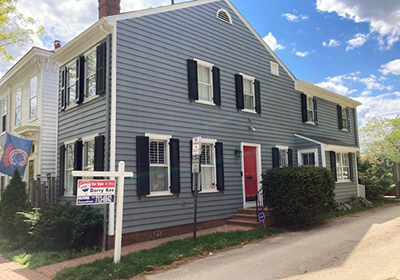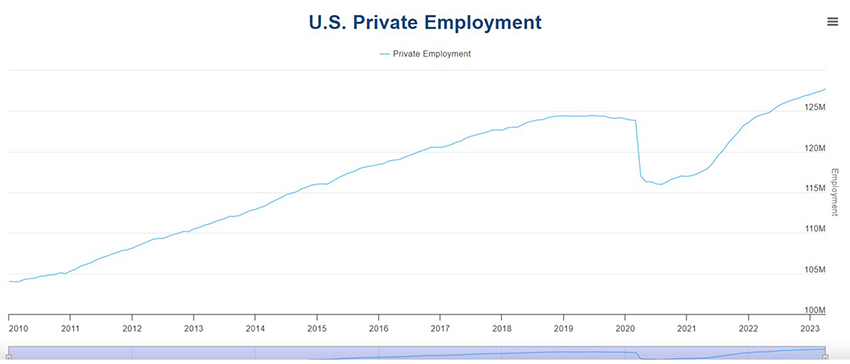
Roundup: April Private-Sector Employment Up 296,000; Home Equity Falters as Housing Market Remains Stalled

In today’s Roundup, ADP reports April private-sector employment rose by nearly 300,000, while ATTOM says quarterly home equity lending data shows a continued drop amid a “stalled” housing market.
ADP: Private-Sector Employment Up 296,000
In the second of four major jobs reports this week, ADP, Roseland, N.J., reported private-sector employment increased by 296,000 jobs in April, while annual pay rose by 6.7 percent year-over-year
The ADP National Employment Report said by sector, goods-producing employers added 67,000 jobs, while the service-providing sector added 229,000 jobs. By size, small employers (1-49 employees) added 121,000 jobs; medium employers (50-499 employees) added 122,000 jobs and large employers added 47,000 jobs.
The report said pay growth continued its nearly year-long slowdown. Job changers in particular saw a dramatic decline, with pay slowing from 14.2 percent growth to 13.2 percent, the slowest pace of growth since November 2021. For people who remained in their job, annual pay grew by 6.7 percent.
“The slowdown in pay growth gives the clearest signal of what’s going on in the labor market right now,” said Nela Richardson, chief economist with ADP. “Employers are hiring aggressively while holding pay gains in check as workers come off the sidelines. Our data also shows fewer people are switching jobs.”

On Thursday, the Labor Department releases its weekly Initial Claims report. And on Friday, BLS releases its monthly Employment Report, showing job creation for April. MBA Chief Economist Mike Fratantoni will provide commentary and analysis in the Monday, May 8 edition of MBA NewsLink.
ATTOM: Home Equity Down Again Across U.S. as Housing Market Remains Stalled
ATTOM, Irvine, Calif., released its first-quarter U.S. Home Equity & Underwater Report, showing 47.2 percent of mortgaged residential properties in the United States were considered equity-rich in the first quarter, down slightly from 48 percent in the fourth quarter.
ATTOM said while that remained close to twice the level of just three years ago, the drop-off in the first three months of 2023 marked the second straight quarterly decline following 10 consecutive gains. The report found that the portion of equity-rich mortgage-payers went down from the fourth quarter to the first quarter in 32 states around the U.S.
Despite the emerging trend in equity-rich mortgages, the report also shows that just 3 percent of mortgaged homes, or one in 33, were considered seriously underwater in the first quarter of 2023. The latest seriously underwater figure was virtually unchanged from 2.9 percent in the prior quarter, and was still down from 3.2 percent a year ago.
“Homeowners across the U.S. continue to sit in a far better position than they were just a few years ago, with historically elevated levels of wealth built up in their properties. However, the recent downturn in the housing market is chipping away at the bounty they reaped from a decade of price surges,” said Rob Barber, chief executive officer for ATTOM. “Home equity has fallen modestly amid a larger slump in profits homeowners are getting when they sell. It’s still too early to call this a long-term trend, and there are reasons to hope for a market turnaround this year. For now, though, various measures suggest that the best of the boom may be behind us.”
The portion of equity-rich mortgages continued to decrease in a majority of states around the U.S. from the fourth quarter to the first quarter, commonly by less than two percentage points. Biggest drops again came in the West, which followed a pattern that began late last year. First-quarter declines were led by Arizona (from 59.9 percent to 56.4 percent), Nevada (down from 52.3 percent to 49 percent), Idaho (down from 61.6 percent to 58.5 percent), Utah (down from 60.3 percent to 58.1 percent) and Washington (down from 58.5 percent to 56.5 percent).
At the other end of the spectrum, the South had four of the five states where the equity-rich share of mortgaged homes increased the most r. The largest increases were in New Mexico (up from 45.6 percent to 48.9 percent), Kentucky (up from 37.2 percent to 40.2 percent), Mississippi (up from 33.2 percent to 35 percent), Oklahoma (up from 35.2 percent to 36.4 percent) and South Carolina (up from 48.9 percent to 49.7 percent).
